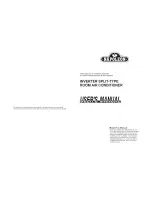
15
v
English
L-2086 Installation
10. Remove both condensing unit base valve stem caps. Open
both base valves fully by turning the valve stems fully coun-
terclockwise. This will allow the refrigerant in the condens-
ing unit to enter the system. Replace and tighten the valve
stem caps.
At this point, the system is basically charged and ready for final
gas charge adjustment once the boat is in the water.
Field Charging the System
To field charge a new unit, which has been evacuated and
basically charged, proceed as follows:
1. Remove both base valve stem caps and confirm that both
valve stems are in the back-seated or full counterclockwise
position.
2. Remove the white gauge port caps from both base valves.
No gas should escape. If it does, retighten the cap and call
Dometic Corporation for assistance.
3. Close all gauge manifold valves.
4. Attach the gauge manifold hoses to the gauge ports: high
pressure on the right and low pressure on the left. Connect
the hose to the refrigerant container.
5. Open both base valves to the test position by rotating the
stems one turn clockwise.
6. Start the unit in the cooling mode, and observe the system
pressures. Use the charging curves shown in Figure 29
to determine the proper pressures. These charts are to
be used as a GUIDE to setting pressures.
They are NOT
designed to give EXACT pressure settings. There are
conditions that may cause pressures to vary. Head pres-
sures may vary +10%.
Accurate Suction Pressure settings are more critical for
proper functioning of the system. Through the gauge
manifold, adjust the gas charge to obtain the proper system
pressures.
7. To remove the gauge manifold, backseat the base valves
by turning the stems fully counterclockwise. Tighten the
stem packing gland nuts. Replace and tighten the stem
caps. Remove the gauge hoses and replace and tighten
the port caps.
Note
It is recommended to charge the system in the cool mode (as
described above). If conditions are such that charging must
be done in the heat cycle, the gauge connections must be re-
versed on the base valves. Also note that in the heat mode the
same pressures can be observed at two different charge levels.
This could lead to an overcharge condition.
Removing Refrigerant from the Sys-
tem
When adjusting the charge in the refrigerant system, you may
have to remove refrigerant. It is a violation of federal law to
vent refrigerant to the atmosphere, and it is necessary that you
capture any refrigerant that is removed from the system. There
are two methods of doing this.
1. Use an approved refrigerant recovery unit and refillable
refrigerant container.
2. Allow refrigerant to escape from the high pressure side into
a refillable refrigerant container.
Initial Start Up
The following instructions apply to both self-contained and
remote condensing systems.
1. Open the seacock (seawater inlet valve).
2. Turn on the circuit breaker for the air conditioner. If a pump
relay is installed, the breaker for the pump must also be
turned on.
3. Following directions in the Operation manual, set the
system for cooling or heating at the switch or SMX keypad,
and adjust temperature setting so the unit will turn on.
4. Verify that water is flowing from the overboard discharge.
Check all overboards if more than one unit is installed.
5. Allow unit to run for 10 minutes at high fan speed. Check
the temperature differential between discharge and return
air by placing an accurate thermometer in front of the dis-
charge grill and then in front of the return air grill.
In cooling, the difference between the discharge and return
should be 15 - 20°F (8.3 - 11.1°C), with normal ambient air
and water temperatures. In the heating mode the differen-
tial can be as high as 25°F (13.9°C).
If everything checks out, the system is ready to go.
Summary of Contents for DX Remote & Self-Contained A/C
Page 2: ......
Page 23: ...23 L 2086 Fig 12 Plenum Configurations Fig 11 Duct and Grill Sizes Tables ...
Page 24: ...24 L 2086 Fig 13a Switch Dimensions and Templates ...
Page 25: ...25 L 2086 Fig 13b Switch Dimensions and Templates ...
Page 26: ...26 L 2086 Fig 14 SHR5 16 StowAway Wiring 082611 Fig 15 SH24C StowAway Wiring 080264 ...
Page 30: ...30 L 2086 Fig 22 R F24 72 3 Ph Cond Unit Wiring 082556 Fig 23 SA3 Z Switch Wiring ...
Page 31: ...31 L 2086 Fig 25 PR3X Pump Relay Wiring Fig 24 SA5 Z Switch Wiring ...
Page 32: ...32 L 2086 Fig 26 PR8X Pump Relay Wiring Fig 27 WFAH System Wiring 115V ...
Page 33: ...33 L 2086 Fig 28 WFAH System Wiring 230V Fig 29 WFAH System Wiring 230V w Aux Heat ...
Page 35: ...35 L 2086 Fig 32 R F Type System Wiring SA3 Z Switch 3Ph ...
Page 36: ...36 L 2086 Fig 33 Refrigerant Charging Curves R22 ...
Page 38: ...NOTES ...
Page 39: ...NOTES ...
















































